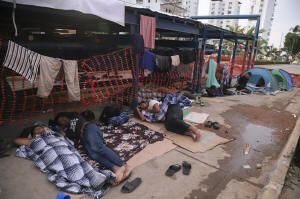Mexico drops migrants in troubled resort as it disperses them far from
US border
 Send a link to a friend
Send a link to a friend
 [January 07, 2025]
By ANTONIO CASTILLO and MARÍA VERZA [January 07, 2025]
By ANTONIO CASTILLO and MARÍA VERZA
ACAPULCO, Mexico (AP) — About 100 migrants from various countries
wandered directionless and disoriented through the streets of the
troubled Pacific coast resort of Acapulco.
After walking for a couple weeks through southern Mexico with hundreds
of other migrants, they accepted an offer from immigration officials to
come to Acapulco with the idea they could continue their journey north
toward the U.S. border. Instead, they found themselves stuck on Monday.
Two weeks ahead of President-elect Donald Trump’s second inauguration,
Mexico continues dissolving attention-grabbing migrant caravans and
dispersing migrants throughout the country to keep them far from the
U.S. border, while simultaneously limiting how many accumulate in any
one place.
The policy of “dispersion and exhaustion” has become the center of the
Mexican government’s immigration policy in recent years and last year
succeeded in significantly reducing the number of migrants reaching the
U.S. border, said Tonatiuh Guillén, former chief of Mexico’s immigration
agency.
Mexico’s current administration hopes that the lower numbers will give
them some defense from Trump’s pressures, said Guillen, who left the
administration of former President Andrés Manuel López Obrador after
Trump threatened to impose tariffs over migration during his first
presidency.

Acapulco would seem to be a strange destination for migrants. Once a
crown jewel of Mexico’s tourism industry, the city now suffers under the
thumb of organized crime and is still struggling to climb back after
taking a direct hit from devastating Hurricane Otis in 2023.
On Monday, Mexican tourists enjoyed the final hours of their holiday
beach vacations while migrants slept in the street or tried to find ways
to resume their journeys north.
“Immigration (officials) told us they were going to give us a permit to
transit the country freely for 10, 15 days and it wasn’t like that,”
said a 28-year-old Venezuelan, Ender Antonio Castañeda. “They left us
dumped here without any way to get out. They won’t sell us (bus)
tickets, they won’t sell us anything.”
Castañeda, like thousands of other migrants, had left the southern city
of Tapachula near the Guatemalan border. More than a half dozen caravans
of about 1,500 migrants each have set out from Tapachula in recent
weeks, but none of them made it very far.
Authorities let them walk for days until they’re exhausted and then
offer to bus them to various cities where they say their immigration
status will be reviewed, which could mean any number of things.
Some have landed in Acapulco, where about a dozen sleep at a Catholic
church near the immigration agency offices.
Several dozen gathered outside the offices Monday looking for
information, but no one would tell them anything. Castañeda, who had
just received money from his family and was desperate to leave, picked a
van driver he judged to be the most trustworthy among various offering
rides for up to five times the normal price for a bus ticket to Mexico
City

[to top of second column]
|

Migrants sleep on the side of a street in Acapulco, Mexico, Monday,
Jan. 6, 2025. (AP Photo/Bernardino Hernandez)

Some migrants have discovered the permits authorities give them allow
them to travel only within the state of Guerrero, where Acapulco is
located. Other migrants have better luck.
On Sunday, the latest migrant caravan broke up after hundreds received
free transit permits to go anywhere in Mexico for a specified number of
days.
Cuban Dayani Sánchez, 33, and her husband were among them.
“We’re a little scared by the lack of safety getting on buses, that
they’re going to stop us,” she said. Mexico’s drug cartels frequently
target migrants for kidnapping and extortion, though many migrants say
authorities extort them too.
Mexican President Claudia Sheinbaum insists her immigration strategy has
a “humanitarian” focus, and has allowed more migrants to leave
southernmost Mexico. But some migration advocates note that migrants are
being taken to violent areas.
It’s a concern shared by the Rev. Leopoldo Morales, the priest at the
Catholic church in Acapulco near the immigration agency office.
He said that in November two or three immigration agency buses arrived
with migrants, including entire families. Last weekend, two more arrived
carrying all adults.
Even though Acapulco isn’t on the usual migration route and was
unprepared to receive migrants, several priests have coordinated support
for them with water, food and clothing. “We know they’re going through a
very difficult time, with a lot of needs, they arrive without money,”
Morales said.
Migrants quickly realize that finding work in Acapulco is difficult.
After Otis’ destruction, the federal government sent hundreds of
soldiers and National Guard troops to provide security and start
reconstruction. Last year, another storm, John, brought widespread
flooding.
But violence in Acapulco hasn’t relented.
Acapulco has one of Mexico’s highest rates of homicides. Cab drivers and
small business owners complain – anonymously – of rising extortion.
Large companies have balked at rebuilding under the current
circumstances.

Honduran Jorge Neftalí Alvarenga was grateful to have escaped the
Mexican state of Chiapas along the Guatemalan border, but was already
disillusioned.
“To an extent they lied to us,” said Alvarenga, who thought he was going
to Mexico City. “We asked for an agreement to send us to (Mexico City)
for work” or other places like Monterrey, an industrial city in the
north with more work opportunities.
Now he doesn’t know what to do.
___
Associated Press writer Edgar H. Clemente in Tapachula, Mexico,
contributed to this report.
All contents © copyright 2024 Associated Press. All rights reserved |